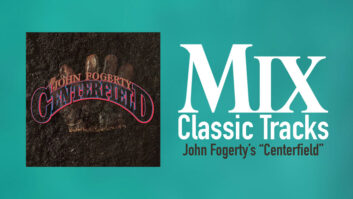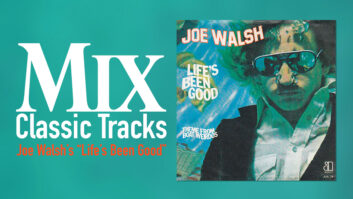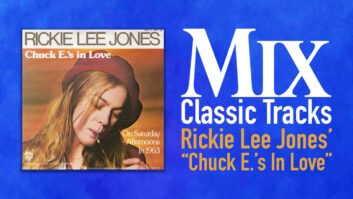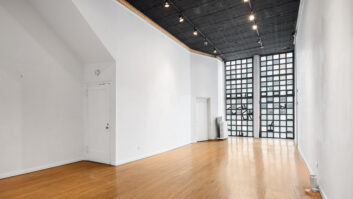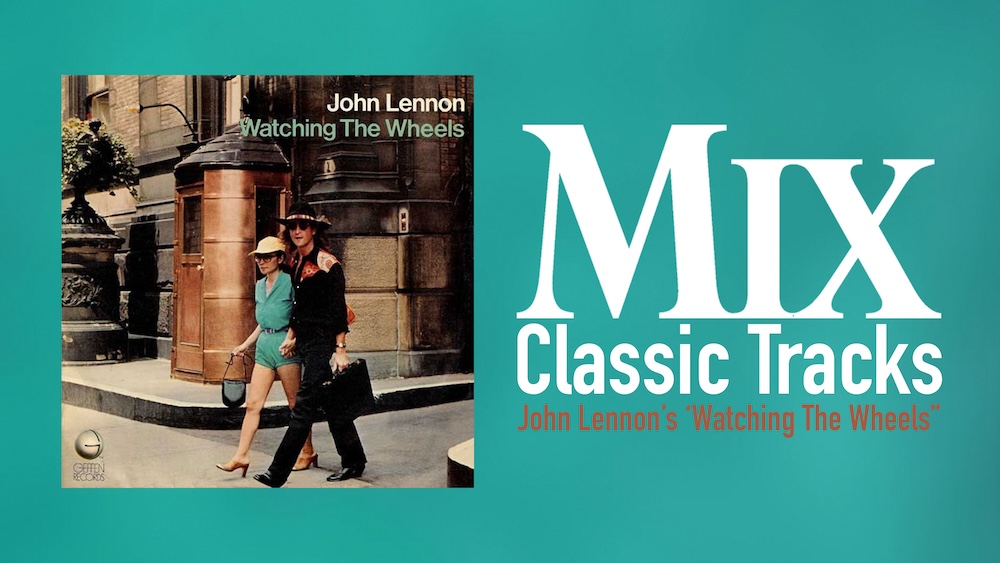
John Lennon and Yoko Ono’s Grammy-winning album Double Fantasy was released in November 1980, just weeks before Lennon’s tragic murder. The disc spawned three Top 10 singles, including “Watching the Wheels,” this month’s “Classic Track,” which producer Jack Douglas counts among his favorite songs on the album.
From the beginning, the Double Fantasy sessions were kept secret. “If word got out, the project was over,” Douglas says. Though it’s hard to imagine today, Douglas says that Lennon was insecure about his singing voice and songwriting abilities after a five-year absence from the studio, and he wanted to keep the project under wraps until he was certain it was viable for release.
Douglas was flown by seaplane to meet secretly with Ono, who handed him a bag of cassette tape demo recordings from Lennon, as well as some 5-inch reels of her own songs. “John’s demos were really primitive,” Douglas explains. “He would record himself playing and singing onto one Panasonic cassette boom box while [assistant] Fred Seaman was banging on a pot or something. Then he’d place that machine next to another Panasonic, and sing or play a harmony while the second machine was recording the first plus his vocal, allowing him to double-track himself.” Most songs included brief spoken introductions.
Douglas’ first task was to assemble a group of musicians to play on the sessions. “He didn’t want to go with his old Plastic Ono Band guys,” such as drummer Jim Keltner, bassist Klaus Voormann and others, Douglas says. “He wanted the New York sound—the sound of New York session guys.”
The approach, as a whole, was to be a new one for Lennon. “He said, ‘This is a play. It’s between a man and his woman,’” recalls Douglas. “It was not going to be a rock album. It was going to be the sound of a mature 40-year-old man who was happy with his life, not a 20-year-old. It was to be a soft sound. He said, ‘You know, we’re going to get all kinds of grief about this, that I’ve lost my edge, et cetera, but the more we get, the more we’ll have succeeded.’”
In keeping with the new approach, Douglas explains, “[Lennon] didn’t want rockers. He wanted guys who were his contemporaries. His music reflected the music of the ’50s, and he wanted guys who could understand that.”
Douglas’ first choices included bassist Willie Weeks, drummer Steve Gadd and legendary keyboardist Nicky Hopkins, who first played with Lennon in 1968, performing the piano solo on The Beatles’ “Revolution” single. “Willie and Steve were not available, and Yoko didn’t want to go with Nicky because she said he and John were trouble together.” Any potential player, in fact, had to pass Ono’s litmus test: numerology.
While Lennon trusted Douglas’ player choices, he wanted at least one musician whom he knew personally, so the producer suggested veteran session guitarist Hugh McCracken, who had played on Lennon and Yoko’s 1971 “Happy Xmas” single, as well as on McCartney’s Ram album that same year. For bass, Douglas suggested Tony Levin, who had worked closely with both Douglas and McCracken from their earliest days recording jingles together in New York. Another veteran session player, Andy Newmark, would handle drums, with percussion by Allen Jenkins Jr., who had worked on several previous albums by Lennon and Ono. Keyboards were played by both Lennon and George Small, a suggestion of Douglas’ business partner, Stan Vincent.
A second guitarist would also play, though he would not appear until the first day of recording. “Earl Slick had played with Bowie—on ‘Fame,’ in fact, which John wrote,” Douglas explains. “But Earl was my wild card. I knew I wanted to bring in one guy that, when he got there, wouldn’t know anything about the recording whatsoever. And he’s very creative and would come up with stuff that was a little off, so it wasn’t just a straight New York session group.”
After a number of telephone conversations in which Lennon gave Douglas specific production ideas, Douglas and arranger Tony DaVillo created parts for the players and final charts, and scheduled two weeks of rehearsals at S.I.R. New York for late July/early August. “It was still a secret who the artist was, so I sang,” Douglas says. “They, of course, cracked up laughing, and saying, ‘C’mon, when are we gonna see the real singer?’”
After each day’s work, Douglas would meet up with Lennon at the Dakota apartments, Lennon and Ono’s famous New York City address, to listen to cassette recordings of the band and fine-tune the arrangements. “It was a blast because John liked to work in bed,” Douglas recalls. “He had a giant bed, which was surrounded with toys: pianos, organs, synths. And above his headboard there was an acoustic guitar, a Hummingbird, and an electric guitar, a Flying V copy called The Sardonicus. He could just reach behind himself and grab one of the guitars without looking.” Douglas would record whatever part Lennon would add, and then incorporate that into the next day’s rehearsals.
Eventually, based on the style of the music they were playing, the band began to guess the artist was a Beatle, especially once they were given the address where the final rehearsal day would take place: The Dakota. “It was mainly just getting together and talking through the music, playing a little bit [in another part of the building],” Douglas says. “Then we went into the residence and just sat and talked for a few minutes.”
The following day, Douglas and the musicians met up at The Hit Factory—a curious choice for Douglas given his longtime association with The Record Plant and his engineering guru there, Roy Cicala. “I chose it because I had to find a place that was off the beaten path, where the fans wouldn’t be looking for us.”
However, Douglas had to be cautious, given the politics of studio alliances. “Ed Germano, who ran The Hit Factory, had left Record Plant with some clients, and he and Roy became enemies,” Douglas says. “I had to explain to Roy, ‘I have to do this because he wants to be working in Midtown. I have to be there now, and you just have to be okay with it.’ It was difficult.”
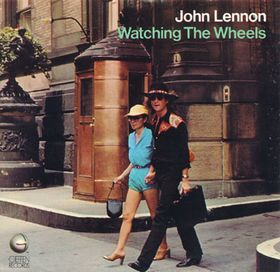
The studio was booked under the name Rich DePalma—an employee of the Lennons, according to Ken Sharp’s comprehensive new oral history of the sessions, Starting Over (Gallery Books/VH1). The sixth-floor studio was only accessible by a secure elevator.
The band arrived on the morning of August 7, 1980, along with engineer Lee DeCarlo. Once the tracking got started, “I was like a race car driver,” Douglas recalls. “I just wanted to go fast and rock. John would always pull me back, saying, ‘Not too much, not too edgy.’ And Lee was able to make that happen for us, keeping the sounds very fat, very high-fidelity, which I really appreciated.”
The room was set up with the two guitarists—McCracken and, now, Slick—facing Lennon, who was in the opposite corner of the room, in an isolation booth, allowing him to both sing live and play guitar, as well as have a direct sightline to McCracken, Slick and Levin. If Lennon was playing an electric guitar, his amp was situated in a smaller, adjacent booth. If he was playing acoustic, he was miked within his vocal booth.
Lennon had a tremendous guitar collection, and he brought all of them to the studio, including his famous ¾-scale black Rickenbacker. “You could see where the headstock had been repaired a number of times,” Douglas says. “And he still had the Shea Stadium set list taped to the back!” Ultimately, Lennon ended up using his two old friends from above his bed—the Hummingbird and the odd-shaped Sardonicus—for everything. “He would always go, ‘Okay, which guitar should I use on this one?’ He’d walk out to his guitars, open a few cases, and then go, ‘Naw, I’ll just use the Sardonicus,’” Douglas says with a laugh.
Lennon always sang live, miked with a Neumann U67. “His singing drove that band,” Douglas says. Often on Double Fantasy, Lennon’s live vocal—with occasional fixes—is heard on the master, double-tracked in the way Lennon had preferred in the ’60s at Abbey Road. The typical process included three or four live takes with the band, after which, as Douglas notes, “[Lennon] would get bored and want to move on,” returning to an unfinished song another time.
“After we had a master take, he’d maybe do three more performances if there were any fixes needed,” Douglas says. “Then he’d leave me alone to comp it: ‘Okay, I’ll come back when you have a vocal and then I’ll double it.’” The studio had a side room in which Lennon would meditate, do yoga or get a massage. “He was one of the easiest artists I ever produced,” recalls Douglas. “He did his job, and then he’d go relax. If we had comps to do, he didn’t sit there: ‘That word’s better. This word’s better.’ He went away, came back—‘That’s what I sound like.’”
Lennon was a master at the microphone, never failing to fascinate Douglas with his technique. “He’d work off to the side of the 67 on certain words to get a different sound. He’d work the side a little bit, then come back out. He’d do rhythms. Best technique I ever saw.”
Lennon also didn’t require a pop filter. “He showed me a trick that I’ve yet to see any other artist do: When he was doing his overdubs, he’d ‘catch’ his ‘p’s. His hand would go by his mouth, and he’d catch the ‘p’ and throw it away.”
Once the double-tracked vocal was recorded, DeCarlo would compress the primary and doubled track together, using a Universal Audio LA-2A, and then run it through a Pultec EQ at about 100 Hz. “It put back a little of the bottom the LA-2A would tend to take out,” Douglas says. The track then received a slap tape echo and some chamber reverb.
The Hit Factory’s array of outboard gear, such as the Pultecs and Fairchild limiters, as well as the studio’s collection of top-notch mics, were part of its draw. “We were able to use 67s as overheads on the drums,” Douglas notes. “You could put a tube 47 in front of the bass drum and an old D12 inside, and an old Beyer on the snare.”
Guitar amps were always miked with three mics: a Sony D30 (set to “M” for music, which added warmth), a Shure SM57 and a Sennheiser 421. “The Sony hung in the middle, and then the other two were arranged to point in, in a ‘V’ formation,” Douglas says. “Then we’d work the phase until it was right.”
McCracken and Slick played hollow-body and solid-body guitars, respectively, which gave them complementary sounds. Douglas recalls a joke the experienced McCracken played on “wild card” Slick on the first day of work: “Earl showed up on the first day and, of course, was really excited when he saw John,” Douglas says. “The other guys had had the benefit of rehearsals and the formal sheet music, so I told Earl, ‘You’re fast—you’ll catch up.’”
According to Douglas, McCracken asked Slick, “You read, right?” referring to the sheet music before him. Not wanting to appear unprofessional, Slick responded, “Of course!” But while Slick was momentarily distracted, McCracken reached over and turned his sheet music upside down, which, of course, Slick didn’t notice. “We started running the song down, and Earl was actually making believe he was reading it. Eventually he started struggling, so Hughie, who was laughing, told him, ‘Ask Jack for a chord chart. It’s just the chords.’”
The Beatles Live! How the Legendary Hollywood Bowl Shows Were Recorded — and Revived Decades Later
“Watching the Wheels” features mainly Lennon on grand piano; George Small, who added the song’s distinctive accented piano riff, on a Rhodes; and Levin on a fretless bass.
During the bridge, just prior to the song’s “I just have to let it go” lines, Lennon wanted a “circular” sound, which Douglas immediately associated with a hammer dulcimer. “It always sounded like wheels turning to me,” he says. The two quickly pulled out the Musician’s Union book, but, alas, found no dulcimer players listed.
Two days later, while walking up Columbus Avenue, Douglas happened upon a young man named Matthew Cunningham playing a hammer dulcimer for dimes and nickels. “I said, ‘You want to do a session? You’ll get paid $100. It’ll be very fast,” says Douglas. Cunningham agreed and soon found himself on the floor of the studio working the part out with Douglas. “I like this song,” he told the producer. “I really like this singer,” he added, completely unaware of who the singer was.
Lennon and Ono arrived shortly thereafter, and Cunningham asked, “Is that the artist?” Douglas answered, “Yes, that’s the artist and his wife.” “Oh.” Excited about the dulcimer sound, Lennon came out into the studio and began working with Cunningham, who still didn’t recognize him. Ono then invited him to join them for lunch, and the four sat together and ate sushi.
Cunningham was paid and sent on his way, but the next day he called Douglas, and said, “I just had a weird feeling. Did I just do a session with John Lennon?” Wanting to keep his sessions a secret, Lennon had Cunningham return to the studio. “He gave him two tickets to Puerto Rico and a paid vacation,” Douglas recalls. “He said, ‘Do me a favor—go take a vacation.’ Gave him some money and sent him away.”
After adding a few more overdubs—including Prophet 5 synth parts played by multi-instrumentalist and singer Eric Troyer—the song was mixed, as were most of the tracks, at Hit Factory. (Two were mixed at Record Plant.)
Upon hearing the final result of “Watching the Wheels,” Lennon gave his thumbs up, satisfied that Double Fantasy was now a reality and that the press could be told. “He turned to Yoko,” Douglas says, “and said, ‘Mother, tell them we have a record.’”
This article was first posted December 8, 2010.

